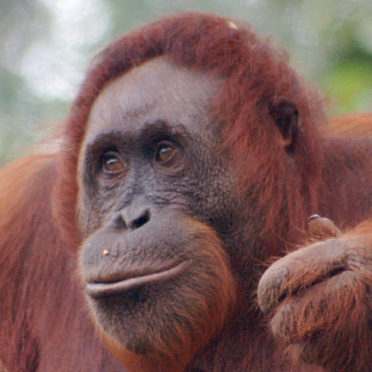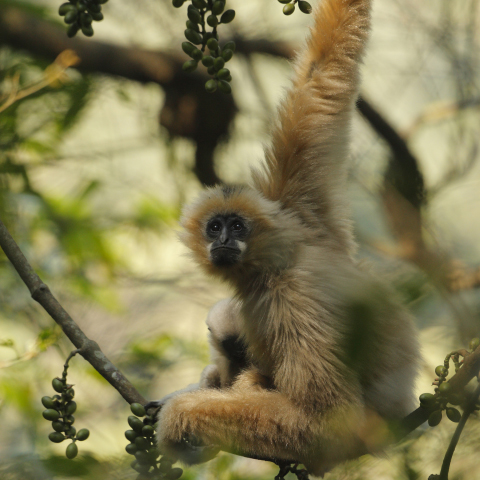Conservation Actions
To ensure the long-term survival of Pongo tapanuliensis, conservation measures need to be implemented swiftly. Due to the rugged terrain, external threats have been primarily limited to illegal clearing of forests, hunting, killings during crop conflict and trade in orangutans (Wich et al. 2012, Wich et al. 2016). A hydroelectric development has been proposed recently in the area of highest orangutan density, which could impact nearly 10% of P. tapanuliensis’ population. This project might lead to further genetic impoverishment and inbreeding, as it would jeopardize chances of maintaining habitat corridors between the western and eastern range, and smaller nature reserves, all of which maintain small populations of P. tapanuliensis.
The Tapanuli Orangutan is also protected by international legislation by default because it is included within the old concept of P. abelii which is listed on CITES Appendix I.
Location Information
For much of the 20th century, orangutans on Sumatra were thought to be restricted to the north and west of Lake Toba, in and around the Leuser Ecosystem. Populations south of Lake Toba were overlooked, even though a 1939 review of the species’ range mentioned that orangutans had been reported in several forest areas in that region (Nederlandsch-Indische Vereeniging tot Natuurbescherming 1939). It was not until 1997 that these isolated orangutan populations were rediscovered (Meijaard 1997, Rijksen and Meijaard 1999). As a consequence of further sightings, published in 2003 (Wich et al. 2003), a study of the southern populations started in 2005 when the Sumatran Orangutan Conservation Programme (SOCP) began a conservation project in the mountainous Batang Toru region with the intent of conserving the orangutan population and their remaining habitat south of Lake Toba.
The only known population of Pongo tapanuliensis occurs in the uplands of the Batang Toru Ecosystem, an area of roughly 1,500 km² consisting of three forest blocks, of which 1,022 km² is suitable orangutan habitat (Wich et al. 2016). Pongo tapanuliensis is the least numerous of all great ape species.
Pongo tapanuliensis was until relatively recently more widespread, with sightings further south in the lowland peat swamp forests in the Lumut area (Wich et al. 2003) and several nests encountered during a rapid survey in 2010 (G. Fredriksson pers. obs.). The forests in the Lumut area have in recent years almost completely been converted to oil-palm plantations. In 2008, a captive Tapanuli Orangutan was confiscated in Lumut. Observation were also made of a male orangutan in the Dolok Ginjang area, just north of the Batang Toru West forest block in the Adiankoting subdistrict in North Tapanuli, during a human conflict situation where an orangutan was shot at with an air rifle when it was found foraging on durian fruits (G. Fredriksson pers. obs.). Recent surveys in this area did not find any orangutan nests (Nowak et al. unpublished data).
A hunting trip report from 1879 described orangutan encounters near the small town of Mantinggi, south of the current population (0°58’ N, 100°0’ E) (Kramm 1879). In 1902, orangutan signs and reports were noted along several small rivers on the south side of the Sibolga Bay, west of Batang Toru (Miller 1903). Unsubstantiated reports suggest that orangutans, presumably P. tapanuliensis, may have occurred even further south in Sumatra in historic periods. A number of museum specimens are claimed to have come from Padang, Palembang and Jambi (Schlegel and Müller 1839–1844, Beccari 1904, Hooijer 1948, Veracini et al. 2010), and an orangutan kill was reported in 1930 near Palembang and along the Musi River toward the base of the Barisan Mountain range (Delmont 1930). These accounts suggest that isolated individuals or small populations of P. tapanuliensis may have survived outside the current range well into the 1900s, although without studying specimens from these areas, we cannot exclude that they could be P. abelii. Despite the distance to the south and their rarity, such reports are perhaps not surprising, as orangutans are long lived and isolated individuals or populations could potentially exist in fragmented landscapes for >50 years, provided that food resources were available and stochastic processes were rare.
Geographic Range
Extant
Indonesia
Population Information
With a population estimate of fewer than 800 individuals (Wich et al. 2016), Pongo tapanuliensis is the least numerous of all great ape species. Its distribution is separated by around 100 km from the closest population of P. abelii to the north. A combination of small population size and geographic isolation is of particularly high conservation concern, as it may lead to inbreeding depression (Hedrick and Kalinowski 2000) and threaten population persistence (Allendorf et al. 2013). Highlighting this, a recent study (Nater et al. 2017) discovered extensive runs of homozygosity in the genomes of two P. tapanuliensis individuals, pointing at the occurrence of recent inbreeding.
Only about 10% of the geographic range is in an area recognized by the World Database of Protected Areas. Another 76% is in Hutan Lindung (Protection Forest), and 14% does not have any 'forest status' in the spatial plans, despite the fact that it consists of rugged primary forest with the highest densities of Tapanuli Orangutans in the Batang Toru Ecosystem (SOCP unpublished data). This roughly translates to 8% of the total distribution located in nationally recognized conservation area (Cagar Alam, Strict Nature Reserve), 78% in Protection Forest (Hutan Lindung), and the remaining 14% of the range is entirely unprotected.






